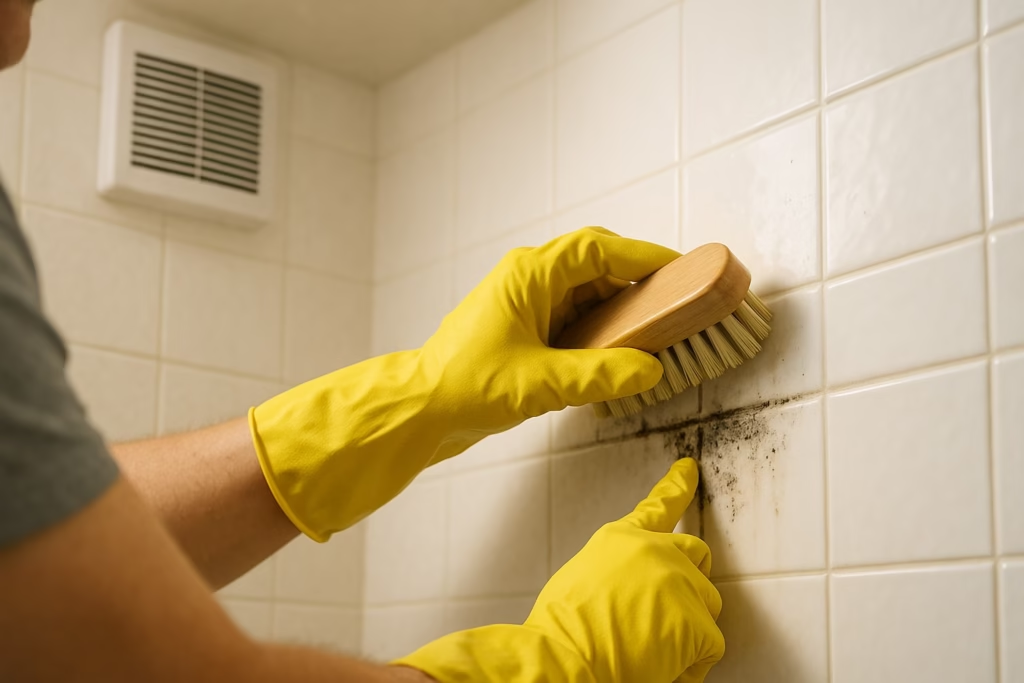Home Remedies for Mold in Shower: Clean, Prevent, and Keep It Away
Read time : 5 mins
Last Updated:
Introduction
Showers are mold magnets: warm water, soap film, and constant humidity. The fix isn’t a mystery—use safer cleaning steps that actually remove residue, dry the surfaces, and keep moisture in check.
This guide gives you a quick, reliable routine for tile, grout, caulk, and glass; what to use (and what not to mix); and small upgrades that keep mold from returning. For broader safety thresholds and when DIY stops being smart, see Home Remedies for Black Mold.
For general methods and materials beyond bathrooms, use our hub: Home Remedies for Cleaning Mold.
Before You Start: Safety & Setup
- Ventilate: run the exhaust fan and crack the door/window.
- PPE: gloves, eye protection, and a well-fitting mask—avoid inhaling dust or spray.
- Supplies: microfiber cloths, soft brush/toothbrush, squeegee, bucket, mild detergent, white vinegar, 3% hydrogen peroxide (for spot use), baking soda (optional), clean water.
- Protect nearby items: move towels, rugs, and toiletries out of the spray zone.
💡 Never mix bleach with ammonia or acids (like vinegar).
Step-by-Step: The Simple Shower Clean (Most Situations)
- Dry wipe: run the fan, then squeegee/wipe walls to remove loose moisture.
- Detergent scrub: mix warm water + a few drops of mild detergent. Scrub tile, grout, and glass; rinse.
- Target stains (choose one method):
1. Vinegar: spray undiluted on non-porous areas; dwell 10–15 min; scrub; rinse.
2. Hydrogen peroxide 3%: spray/soak stained grout or caulk; dwell 10–15 min; scrub; rinse. Spot-test first.
3. Baking soda paste: (baking soda + a little water) for localized staining; scrub; rinse. - Rinse well with clean water.
- Dry completely: squeegee, towel dry, and keep the fan running 20–30 minutes.
💡 Tip: “Kill” ≠ remove. Always scrub, rinse, and dry to get spores and residue off the surface.
Tile, Grout, Caulk, and Glass: Specifics
- Tile & glass: detergent → vinegar or peroxide (not both the same session) → rinse → dry.
- Grout: detergent first; then spot peroxide or a baking-soda paste; reseal grout when fully dry to slow future growth.
- Caulk: if discoloration returns quickly or the bead is degraded, remove and re-caulk (mold-resistant silicone) once the area is fully dry.
Daily & Weekly Habits That Stop Regrowth
- After every shower: squeegee walls/door; run the fan 20–30 minutes.
- Keep RH ~30–50%: if humidity lingers, use a small dehumidifier.
- Door open to dry: leave the shower door/curtain partially open.
- Weekly quick clean: fast detergent scrub + rinse + dry.
- Quarterly maintenance: reseal grout; check fan flows (paper-towel test at the grille).
Upgrades That Help (Small Time, Big Payoff)
- Fan timer switch (auto-off after 30–60 minutes).
- Stronger exhaust fan (measured at the grille) if humidity lingers.
- Silicone caulk labeled mold-resistant; smooth beads to avoid water pockets.
- Water softener or rinse aid if hard water scale traps buildup.
When to Call a Pro
- Mold keeps returning behind tile or walls, soft spots, or musty odors = possible hidden moisture.
- Large areas of damaged drywall/ceiling adjacent to the shower.
- HVAC involvement or health symptoms during/after showers.
See the thresholds and safety notes in Home Remedies for Black Mold.
Conclusion
Shower mold fades fast when you pair simple cleaning (detergent → targeted stain treatment → rinse) with consistent drying (squeegee + fan time). Keep relative humidity around 30–50%, reseal grout periodically, and upgrade your fan or habits if moisture lingers.
If stains return from within caulk or walls, replace materials and fix the moisture source rather than fighting the surface forever.
For whole-home methods and other materials, see the Cleaning Mold hub.
FAQ
Question: What’s the fastest safe way to clean shower mold?
Answer: Detergent scrub, then one targeted treatment (vinegar or 3% peroxide), rinse well, and dry with a squeegee and fan.
Question: Vinegar or peroxide—which is better?
Answer: Both can help. Don’t mix or layer them the same day. Spot-test, use one, rinse, and save the other for a future session if needed.
Question: Why does mold keep returning on the caulk line?
Answer: Moisture is trapped or the bead is deteriorated. Remove and re-caulk once the substrate is dry; then improve ventilation and fan runtime.
Question: How long should I run the bathroom fan?
Answer: During the shower and 20–30 minutes after. If mirrors stay foggy, upgrade the fan or add a timer switch.
By: Home Remedy Center Editorial Team
The Home Remedy Center Editorial Team researches practical, safe ways to care for your home and family. Our writers and editors fact-check every guide against reputable sources and trade standards, and we keep advice simple, realistic, and safety-first. Learn more about our Editorial Policy at Editorial Policy.
Disclaimer: This article is for educational purposes and is not medical or professional advice.
Last updated:

